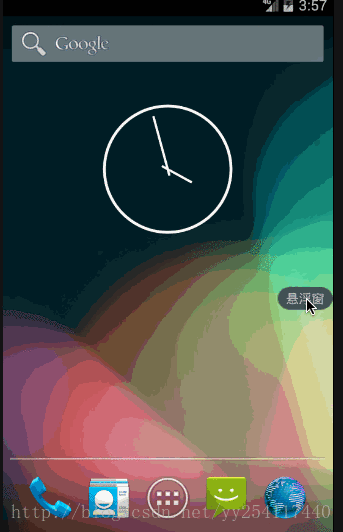
整体思路
360手机卫士的内存球其实就是一个没有画面的应用程序,整个应用程序的主体是一个Service。我们的程序开始以后,启动一个service,同时关闭activity即可:
public class MainActivity extends Activity {private static final String TAG = MainActivity.class.getSimpleName();@Overrideprotected void onCreate(Bundle savedInstanceState) {super.onCreate(savedInstanceState);startService(new Intent(this, FloatWindowService.class));finish();}}import android.os.IBinder;import android.util.Log;import java.util.Timer;import java.util.TimerTask;public class FloatWindowService extends Service {private static final String TAG = FloatWindowService.class.getSimpleName();public FloatWindowService() {}@Overridepublic int onStartCommand(Intent intent, int flags, int startId) {Log.d(TAG, "on start command");FloatWindowManager.instance(getApplicationContext()).createFloatWindow();return super.onStartCommand(intent, flags, startId);}@Overridepublic IBinder onBind(Intent intent) {// TODO: Return the communication channel to the service.throw new UnsupportedOperationException("Not yet implemented");}}我们要注意的是,传统的Service默认是运行在UI线程中的,这点与封装了一个Thread和Handler的intentService不同,所以我们可以直接在Service中更改UI相关的内容。public void createFloatWindow() {if (isWindowShowing()) return;WindowManager windowManager = getWindowManger(context);int screenWidth = windowManager.getDefaultDisplay().getWidth();int screenHeight = windowManager.getDefaultDisplay().getHeight();if (floatLayout == null) {floatLayout = new FloatLayout(context);if (smallLayoutParams == null) {smallLayoutParams = new WindowManager.LayoutParams();smallLayoutParams.type = WindowManager.LayoutParams.TYPE_PHONE;smallLayoutParams.format = PixelFormat.RGBA_8888;smallLayoutParams.flags = WindowManager.LayoutParams.FLAG_NOT_TOUCH_MODAL| WindowManager.LayoutParams.FLAG_NOT_FOCUSABLE;smallLayoutParams.gravity = Gravity.LEFT | Gravity.TOP;smallLayoutParams.width = FloatLayout.viewWidth;smallLayoutParams.height = FloatLayout.viewHeight;smallLayoutParams.x = screenWidth;smallLayoutParams.y = screenHeight / 2;}}windowManager.addView(floatLayout,smallLayoutParams);}以及自定义的View:<?xml version="1.0" encoding="utf-8"?><LinearLayout xmlns:android="http://schemas.android.com/apk/res/android"android:id="@+id/small_layout"android:background="@drawable/bg_small"android:orientation="vertical" android:layout_width="60dip"android:layout_height="25dip"><TextViewandroid:layout_width="match_parent"android:gravity="center"android:text="悬浮窗"android:layout_height="match_parent" /></LinearLayout>
public class FloatLayout extends LinearLayout {public static int viewWidth;public static int viewHeight;private WindowManager windowManager;public FloatLayout(final Context context) {super(context);windowManager = (WindowManager) context.getSystemService(Context.WINDOW_SERVICE);LayoutInflater.from(context).inflate(R.layout.small_layout, this);View view = findViewById(R.id.small_layout);viewWidth = view.getLayoutParams().width;viewHeight = view.getLayoutParams().height;setOnTouchListener(new OnTouchListener() {@Overridepublic boolean onTouch(View v, MotionEvent event) {FloatWindowManager.instance(context).createFloatMenu();return true;}});}}自定义的View除了加载了一个布局,就是设置了一个Touch监听器,用于点击悬浮窗弹出菜单。注意这里要使用 view.getLayoutParams() 来获取视图的宽和高,因为在构造方法中,这个View并没有被measure完成,所以采用view.getHeight得到的宽高是0。public void createFloatMenu() {if (menuLayout != null) return;Log.d(TAG, "create float menu");WindowManager windowManager = getWindowManger(context);if (menuLayout == null){menuLayout = new MenuLayout(context);menuLayoutParams = new WindowManager.LayoutParams();menuLayoutParams.type = WindowManager.LayoutParams.TYPE_PHONE;menuLayoutParams.format = PixelFormat.RGBA_8888;}windowManager.addView(menuLayout,menuLayoutParams);}自定义的菜单将背景设置成半透明,同时分成上下两部分,上部分点击删除菜单,下部分是一些展示的内容:<?xml version="1.0" encoding="utf-8"?><LinearLayout xmlns:android="http://schemas.android.com/apk/res/android"android:orientation="vertical" android:layout_width="match_parent"android:background="#96000000"android:layout_height="match_parent"><LinearLayoutandroid:layout_width="match_parent"android:id="@+id/trans_part"android:orientation="horizontal"android:layout_weight="1"android:layout_height="0dp"></LinearLayout><LinearLayoutandroid:layout_width="match_parent"android:layout_weight="1"android:background="@color/colorPrimary"android:layout_height="0dp"><TextViewandroid:layout_width="match_parent"android:text="存放content"android:layout_height="match_parent" /></LinearLayout></LinearLayout>
public class MenuLayout extends LinearLayout {public MenuLayout(final Context context) {super(context);LayoutInflater.from(context).inflate(R.layout.transparent_layout,this);View view = findViewById(R.id.trans_part);view.setOnClickListener(new OnClickListener() {@Overridepublic void onClick(View v) {FloatWindowManager.instance(context).removeMenuLayout();}});}}可以看见,实现悬浮窗,其实就是通过windowManager.addView 时,在LayoutParam 的type设置为TYPE_PHONE,这样你的视图就是系统级视图,可以覆盖在全部程序的最上面。其余的,更多的是自定义View的知识。